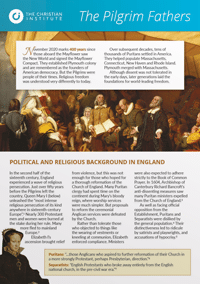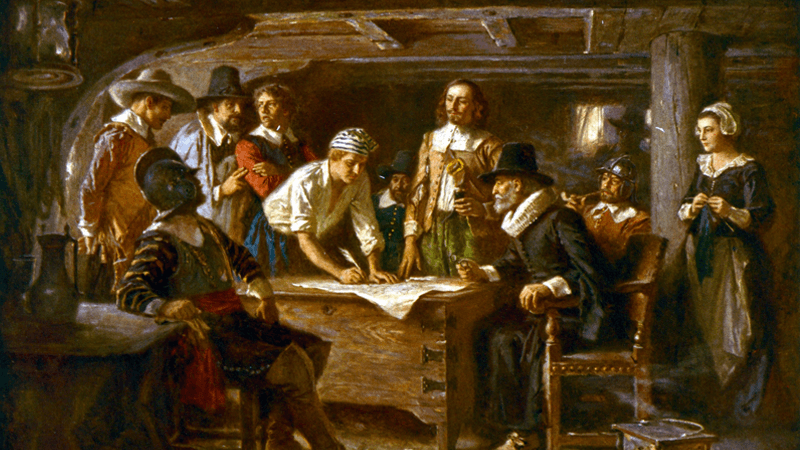Coming soon…

The Pilgrim Fathers
November 2020 marks 400 years since those aboard the Mayflower saw the New World and signed the Mayflower Compact.

On this day in 1620, the Pilgrim Fathers set sail for the New World aboard the Mayflower.
In the decades to come, tens of thousands of Puritans would follow them to settle in Massachusetts, Connecticut, New Haven and Rhode Island. They sailed in pursuit of religious freedom, and over the years the foundations were laid for an example that would be admired around the world.
This was a freedom born out of tribulation.
In 16th century England, believers had experienced dire persecution at the hands of Queen Mary I. Nearly 300 Protestant men and women were burned at the stake during her rule. Many more fled to mainland Europe.
While Elizabeth I’s accession brought relief from violence, those who hoped for a thorough reformation of the Church of England grew increasingly frustrated. Proposals to reform the ceremonial Anglican services were routinely defeated. But rather than tolerate those who objected to religious trappings such as the wearing of vestments or kneeling at communion, Elizabeth enforced compliance. Then, in 1604, Archbishop of Canterbury Richard Bancroft’s anti-dissenting measures saw many Puritan ministers expelled from the Church of England.
As well as facing official opposition from the Establishment, Puritans and Separatists were disliked by the general population. Their distinctiveness led to ridicule by satirists and playwrights, and accusations of hypocrisy.
After years of worshipping in secret, in 1608 many fled to the Netherlands. There they found the religious freedom they were searching for and settled in the university town of Leiden. However, living conditions were poor. Many found the language and culture difficult, and were concerned that their children were growing up ‘foreigners’.Puritans and Separatists were disliked by the general population. Their distinctiveness led to ridicule by satirists and playwrights, and accusations of hypocrisy.
Plans were made for America, and the historic voyage set sail in 1620.

November 2020 marks 400 years since those aboard the Mayflower saw the New World and signed the Mayflower Compact.
The Mayflower carried people with varying backgrounds and differing religious convictions. As well as those seeking the freedom to worship outside the Church of England, some were simply making the journey for business reasons. Tensions between the two groups led to the Mayflower Compact, a covenant signed by most male passengers to work together for the common good (image above).
Among those on board was William Bradford, the future Governor of Plymouth colony. His introduction to life in the new world was abrupt and harsh. Taking on the role following the death of the first Governor, John Carver, Bradford had to manage the difficulties of very different groups of people living closely together. Meanwhile, the Pilgrims’ numbers dwindled rapidly – more than half the colony died in the first winter.
In March 1630 there were more arrivals; emigrants from the Old World, carrying with them a charter from the king, a clear mandate to create a nation.
Among them, the first recorded female published poet, Anne Bradstreet. Ahead of her a life filled with trials: the deaths of three grandchildren, the destruction of her house by fire, and near constant sickness. Yet in her writings, it is the sovereignty of God that shines through, not her personal difficulties.
The Pilgrims didn’t get everything right. Puritans generally believed that “the goal of government in church and state was… to produce godliness”. Their vision was for a Christian covenant community, a “city upon a hill”.
This meant religious freedom was limited in the early days. Disagreement was seen as a threat to the stability of society and had to be dealt with. But the religious liberty eventually established in Rhode Island by Royal Charter in 1663 was the blueprint for freedom in what would later become the United States of America.Puritans and Separatists were disliked by the general population. Their distinctiveness led to ridicule by satirists and playwrights, and accusations of hypocrisy.
In Massachusetts freedom to worship according to your own beliefs gradually became accepted. By the close of the 17th century, New Jersey, Carolina and Pennsylvania were given charters with a degree of religious freedom, although participation in public life was still limited for many years.
The Pilgrim Fathers’ fervent desire was to be able to worship God freely, yet their early years in America included repeated acts of religious intolerance.
We should be glad that in Britain today, people are not forced to attend church, for example. Even if it means people live as if there were no God or worship a false god, this is the price of true religious freedom. However, believers should still urge the civil authorities to pass laws that uphold biblical standards because we know that they are for the good of everyone – our neighbour as well as ourselves – to the glory of God.